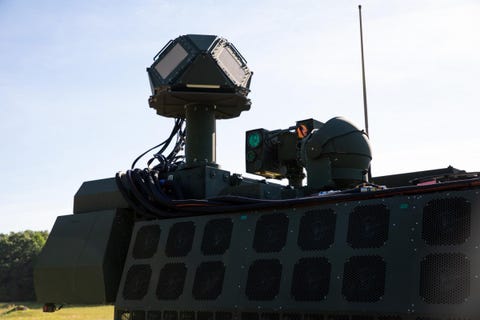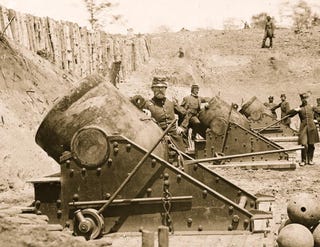KYLE MIZOKAMI

A laser system designed to protect ground troops from drones and aircraft has been used to successfully shoot mortar bombs out of the sky. The U.S. Army’s DE M-SHORAD laser weapon system downed several mortar bombs in a series of tests, making it one of the few, if any weapons in the history of warfare, capable of protecting troops from indirect fire weapons. If the system proves useful against larger shells and rockets, it could stand modern warfare on its head.
The tests, according to Raytheon, took place at the U.S. Army’s White Sands Missile Range in New Mexico. The DE M-SHORAD system “acquired, tracked, targeted and defeated” multiple 60mm mortar rounds in mid-flight.

The laser and sensor mast of DE M-SHORADS. JIM KENDALL/U.S. ARMY
The Directed Energy Maneuver-Short Range Air Defense (DE M-SHORAD) consists of a 50kW-class high energy laser weapon module, a specialized radar acquisition system, a beam control system and targeting sensor mounted on a Stryker armored vehicle. DE M-SHORAD’s original emphasis was on protecting ground troops from fixed wing aircraft, helicopters, and drones of all kinds. Raytheon now says the laser can engage “rockets, artillery, and mortars.”
A mortar is a simple, lightweight artillery piece used by infantry. A mortar typically consists of a steel tube and a heavy baseplate. A mortar bomb, typically filled with high explosive, is dropped tail-first into the tube. Once it hits the bottom of the tube, the bomb strikes a firing pin and ignites a propellant charge. The bomb flies out of the tube and downrange at the target. Soldiers adjust the range by raising or lowering the muzzle of the mortar tube, giving the shell a higher or lower trajectory.

Mortars were used by both sides during the Civil War, including at the siege of Yorktown, 1862. BUYENLARGEGETTY IMAGES
There’s a lot that isn’t clear about the test. We don’t know if the laser system shot down all of the mortar bombs, most of them, or just some of them. We don’t know if DE M-SHORAD engaged the bombs head-on or from an angle, and if the bombs were on a high or low trajectory, which could affect sensor tracking and engagement. We also don’t know how the laser defeated the bombs, either by heating the surface and detonating the explosives—if any—inside or by burning off the mortar’s control fins off.
Still, this is a historic moment. Artillery shells have vexed ground troops for hundreds of years. Indirect fire, the use of artillery to fire at targets out of the gun’s direct line of sight, is a particular problem as the shell can travel for miles, far beyond the reach of their targets. Once fired, there’s little anyone can do about them other than to take cover and hope for the best. That’s why there’s such an emphasis on locating artillery pieces on the battlefield and destroying them before they can get a shot off.
The system works against mortar bombs, but how DE M-SHORADS does against heavier 155mm howitzers rounds and artillery rockets such as the Russian 122mm Grad-P remains to be seen. If successful it could provide a shield for ground troops, protecting friendly forces from bombardments. A system such as the Finnish RM-70 multiple launch rocket system, which can unleash 40 rockets in less than a minute, would be a particular challenge.
This content is imported from YouTube. You may be able to find the same content in another format, or you may be able to find more information, at their web site.
A laser is the ideal weapon to engage artillery. An anti-artillery missile would likely cost tens of thousands of dollars each, while the artillery shell itself might cost as little as $500. An army might protect itself from artillery but in doing so bankrupt itself. The cost of firing a laser is basically the cost of the diesel fuel powering the weapon’s generator.
DE M-SHORADS still has to prove itself against bigger, badder artillery but the mortar tests are a promising development. Soldiers on the ground may finally be able to do more than take cover at the whistling of artillery—they might soon be able to actually shoot the incoming shells down. The dream of tens, if not hundreds of millions of soldiers forced to take cover from artillery fire over the centuries is finally coming true.
No comments:
Post a Comment